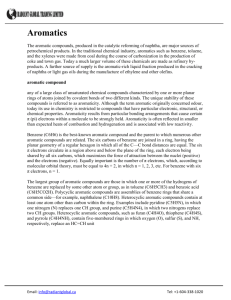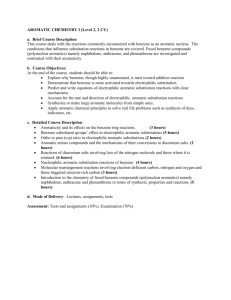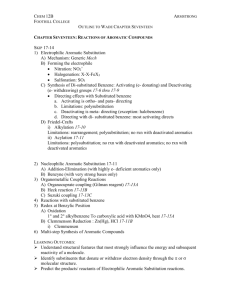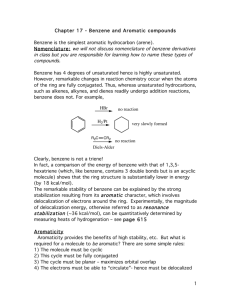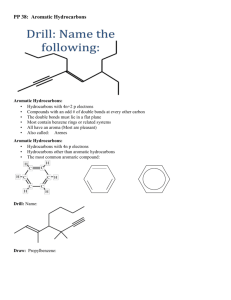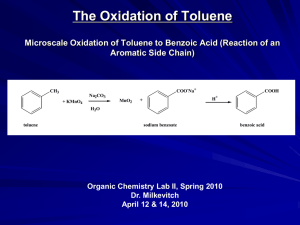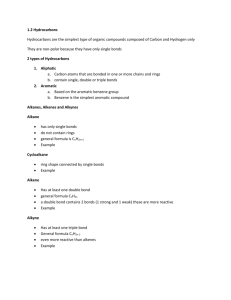CHAPTER 15 (Benzene and Aromaticity
advertisement
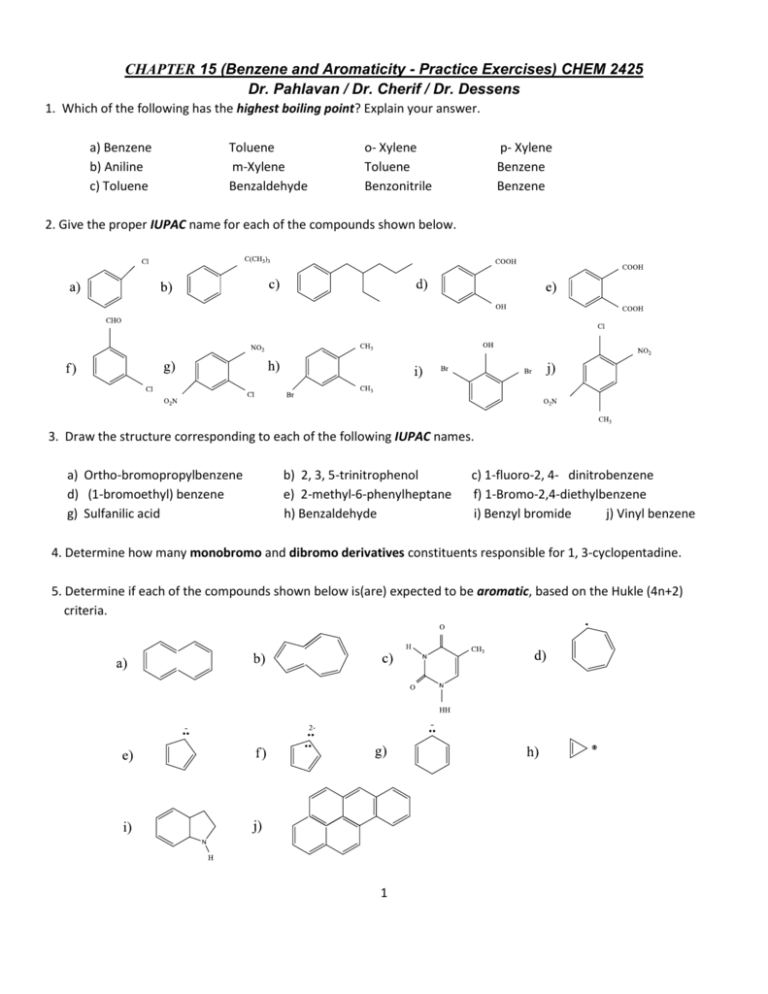
CHAPTER 15 (Benzene and Aromaticity - Practice Exercises) CHEM 2425 Dr. Pahlavan / Dr. Cherif / Dr. Dessens 1. Which of the following has the highest boiling point? Explain your answer. a) Benzene b) Aniline c) Toluene Toluene m-Xylene Benzaldehyde o- Xylene Toluene Benzonitrile p- Xylene Benzene Benzene 2. Give the proper IUPAC name for each of the compounds shown below. 3. Draw the structure corresponding to each of the following IUPAC names. a) Ortho-bromopropylbenzene d) (1-bromoethyl) benzene g) Sulfanilic acid b) 2, 3, 5-trinitrophenol e) 2-methyl-6-phenylheptane h) Benzaldehyde c) 1-fluoro-2, 4- dinitrobenzene f) 1-Bromo-2,4-diethylbenzene i) Benzyl bromide j) Vinyl benzene 4. Determine how many monobromo and dibromo derivatives constituents responsible for 1, 3-cyclopentadine. 5. Determine if each of the compounds shown below is(are) expected to be aromatic, based on the Hukle (4n+2) criteria. 1 6. Give four reasons for unusual stability of benzene. 7. Compare the stability of cyclohexene, 1, 3-cyclohexadiene, and benzene bases on heat of hydrogenation. 8. What are the aromaticity conditions. Give an example of aromatic compound, anti-aromatic, and non-aromatic compound. 9. What are the aromatic heterocycles aromatic and polycyclic aromatic compounds? Given examples of heterocyclic and polycyclic compounds. 10. What type of reactions benzene and benzene derivatives typically undergo? Provide at least two examples. 2 ANSWERS CHAPTER 15 (Benzene and Aromaticity - Practice Exercises) CHEM 2425 Dr. Pahlavan / Dr. Cherif / Dr. Dessens 1. a) o – Xylene (144 oC) group crowding 2. a) Chlorobenzene d) o – Hydroxybenzoic acid f) m - Chlorobenzaldehyde i) 2,6 dibromophenol b) Aniline (184 oC) hydrogen bonding c) Benzonitrile (191 oC) polarity b) t-Butylbenzene c) (2-Ethylpentyl)benzene or 2-Ethyl-1-phenylpentane e) 1,2 – benzene dicarboxylic acid or Phthalic acid g) 2 – Chloro -1,4 –dinitrobenzene h) 4 – Bromo- 1,2- dimethylbenzene j) 4 –Chloro- 2,5 –dinitrotoluene j) 4 –Chloro- 2,5 –dinitrotoluene 3. a) g) b) c) d) h) e) i) f) j) 4. 5. a) 10 pi electron, all sp2 atoms ,not planar, non-aromatic c) conjugated aromatic (partially) e) 6 pi electrons, all sp2, aromatic g) 6 pi electrons, not all sp2, non-aromatic i) not monocyclic, not all sp2 not-aromatic b) not monocyclic , anti-aromatic d) 6 pi electrons , aromatic f) 6 pi electrons, all sp2, aromatic h) 2 pi electrons , all sp2, aromatic j) if all sp2 ,anti-aromatic 3 6. i) Benzene is a planar molecule with the shape of regular hexagon ii) Heat of hydrogenation is less than expected iii) All C – C – C bond angles are 120 o, all six carbon atoms are sp2 hybridized iv) All C – C bonds have the same length (139 pm) v) Conjugated with p orbital on each carbon vi) Kekule resonance structures 7. Compare heat of hydrogenations a) Cyclohexane b) 1,3 - Cyclohexadiene c) Benzene a) ∆Hhyd = - 118 kJ/mol (least stable) ∆ Hhyd = 2 x (-118) = - 230 kJ /mol ∆Hhyd = - 206 kJ/mol (most stable) b) c) 8. I) Flat- Mono cyclic – completely conjugated a) Aromatic – obey (4n +2 pi e’s rule = 2,6,10, 14, …. Pi electrons) b) Anti- aromatic – contains 4, 8, 12, 16, … pi electrons II) Not – Flat , not cyclic, not completely conjugated- nonplanar or non-cyclicor not conjugated ……. The entire ring. 9. Aromatic hetrocyclic is a cyclic compound that contains an atom other than carbon in the ring (pyridine). Polyaromatic compound is a compounds with two or more benzene-like rings fused together(anthracene). Pyridine anthracene 10. Electophilic Aromatic Substitution (EAS) i) ii) 4



